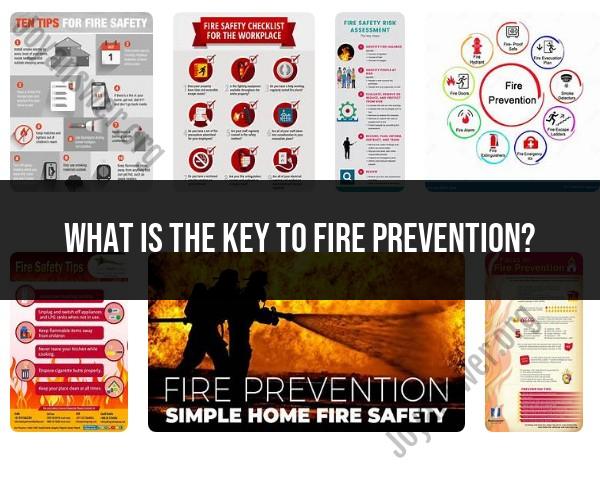What is the key to fire prevention?
The key to fire prevention lies in understanding and implementing a combination of proactive measures that collectively reduce the risk of fires in various environments. Here are key principles and preventative measures that contribute to effective fire prevention:
Education and Awareness:
- Understanding Fire Basics: Educate individuals about the fire triangle—heat, fuel, and oxygen—and how fires start and spread.
- Training and Drills: Conduct regular fire safety training and evacuation drills to ensure that individuals know how to respond in case of a fire emergency.
Risk Assessment:
- Identify Hazards: Conduct thorough risk assessments to identify potential fire hazards in the workplace or home.
- Mitigation Strategies: Implement strategies to mitigate identified risks, such as proper storage of flammable materials and addressing electrical issues.
Safe Handling of Flammable Materials:
- Storage Procedures: Establish proper storage protocols for flammable materials, chemicals, and combustible substances.
- Labeling: Clearly label and store hazardous materials in accordance with safety guidelines.
Electrical Safety:
- Regular Maintenance: Perform regular inspections and maintenance of electrical systems and equipment.
- Overload Prevention: Avoid overloading electrical circuits and use appropriate wiring for electrical appliances.
Smoking Policies:
- Designated Areas: Establish designated smoking areas away from flammable materials.
- Enforce Policies: Enforce no-smoking policies in areas where smoking poses a fire risk.
Fire-Resistant Building Materials:
- Construction Materials: Use fire-resistant materials in building construction to slow down the spread of fires.
- Fire Barriers: Install fire barriers to compartmentalize and contain potential fire incidents.
Emergency Exit Planning:
- Escape Routes: Clearly mark and communicate evacuation routes.
- Emergency Exits: Ensure that emergency exits are easily accessible and well-maintained.
Fire Detection and Alarm Systems:
- Regular Testing: Regularly test and maintain fire detection and alarm systems.
- Immediate Response: Ensure that alarms are connected to emergency services for a prompt response.
Fire Extinguishers and Suppression Systems:
- Proper Placement: Install fire extinguishers in strategic locations and ensure they are easily accessible.
- Training: Train individuals on the proper use of fire extinguishers and other suppression systems.
Cooking Safety:
- Supervision: Never leave cooking appliances unattended.
- Cleanliness: Keep cooking areas clean to reduce the risk of grease fires.
Heating Equipment Safety:
- Maintenance: Regularly service and maintain heating equipment.
- Clearance: Keep flammable materials away from heating sources.
Spark and Hot Work Safety:
- Permit Systems: Implement permit systems for hot work activities.
- Monitoring: Monitor and control activities that generate sparks or involve open flames.
Regular Inspections:
- Fire Safety Audits: Conduct regular fire safety audits to identify and address potential issues.
- Compliance Checks: Ensure compliance with local fire safety regulations and codes.
First Aid and Emergency Response:
- First Aid Training: Provide basic first aid training to individuals to address injuries caused by fires.
- Emergency Services Contact: Clearly communicate emergency contact information.
Employee Involvement:
- Reporting Systems: Encourage employees to report potential fire hazards or unsafe conditions.
- Safety Committees: Establish safety committees to involve employees in fire prevention initiatives.
Continuous Improvement:
- Feedback Mechanisms: Establish mechanisms for feedback and continuous improvement in fire prevention measures.
- Adaptation: Stay informed about new technologies and best practices for fire prevention.
Implementing a comprehensive fire prevention strategy involves a combination of education, proactive measures, and ongoing vigilance. It requires a collaborative effort from individuals, organizations, and communities to create a safe and fire-resistant environment. Regular training, awareness campaigns, and adherence to established safety protocols are critical components of successful fire prevention efforts.
Fire Prevention: Key Principles, Strategies, and Contributing Factors
1. Fundamental Principles of Fire Prevention:
- Control the three elements of fire: fuel, heat, and oxygen. This involves minimizing flammable materials, controlling heat sources, and ensuring proper ventilation.
- Identify and address fire hazards. Regularly inspect for potential fire hazards such as faulty electrical wiring, overloaded outlets, flammable liquids stored improperly, and blocked escape routes.
- Implement safe practices. This includes using appliances correctly, maintaining proper housekeeping, practicing proper smoking habits, and storing flammable materials safely.
- Develop and maintain emergency plans. This includes having an escape plan with designated exits and meeting points, knowing how to use fire extinguishers and activate fire alarms, and practicing evacuation drills regularly.
- Educate and train occupants. Ensure everyone understands fire prevention principles, emergency procedures, and the importance of reporting fire hazards immediately.
2. Education and Awareness for Effective Fire Prevention:
- Public awareness campaigns: Inform the public about fire safety risks, prevention measures, and emergency response procedures through campaigns, educational materials, and community outreach programs.
- School fire safety programs: Integrate fire safety education into school curriculums, teaching children fire prevention principles, safe practices, and emergency response plans.
- Workplace training programs: Provide employees with comprehensive fire safety training covering hazard identification, safe work practices, fire extinguisher operation, and evacuation procedures.
- Community engagement: Organize fire safety events, workshops, and demonstrations to engage the community, promote awareness, and encourage responsible behavior.
3. The Role of Regulations and Technology in Fire Prevention:
- Building codes and regulations: Enforce building codes that require fire-resistant materials, proper fire detection and alarm systems, and adequate means of egress in buildings.
- Product safety standards: Implement and enforce safety standards for appliances, electrical equipment, and other products to minimize fire risks.
- Advanced fire detection and suppression technology: Utilize smoke detectors, sprinkler systems, fire alarms, and other technology to detect fires early and suppress them quickly.
- Data analysis and risk assessment: Analyze fire incident data to identify patterns, evaluate risk factors, and develop targeted prevention strategies.
By adopting these fundamental principles, promoting education and awareness, and leveraging regulations and technology, we can significantly reduce the risk of fires and create a safer environment for everyone.













